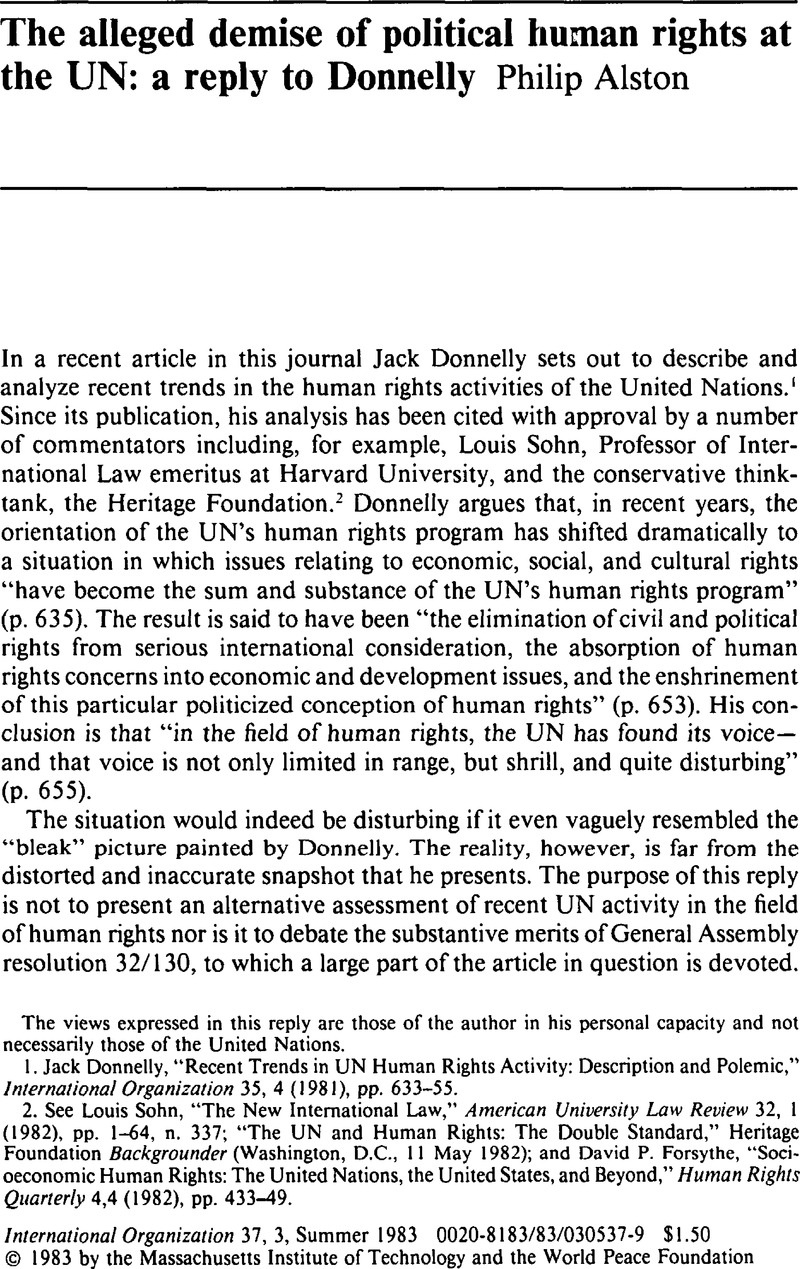Published online by Cambridge University Press: 22 May 2009

The views expressed in this reply are those of the author in his personal capacity and not necessarily those of the United Nations.
1. Donnelly, Jack, “Recent Trends in UN Human Rights Activity: Description and Polemic,“ International Organization 35, 4 (1981), pp. 633–55CrossRefGoogle Scholar.
2. See Sohn, Louis, “The New International Law” American University Law Review 32, 1 (1982), pp. 1–64, n. 337Google Scholar; “The UN and Human Rights: The Double Standard” Heritage Foundation Backgrounder (Washington, D.C., 11 05 1982)Google Scholar; and Forsythe, David P., “Socioeconomic Human Rights: The United Nations, the United States, and Beyond” Human Rights Quarterly 4, 4 (1982), pp. 433–49CrossRefGoogle Scholar.
3. For the purposes of this reply the term “economic rights” is used to refer to the rights contained in the International Covenant on Economic, Social and Cultural Rights and the term “political rights” to refer to those contained in the International Covenant on Civil and Political Rights.
4. It is described in detail in United Nations Action in the Field of Human Rights (ST/HR/2/Rev.l; Sales number E.79.XIV.6), pp. 259–309.
5. The reference to the doctrinal competence of the General Assembly does not justify Donnelly's exclusion of other organs, since he is dealing not only with doctrine but with the “sum and substance of the UN's human rights program” (p. 635).
6. See General Assembly resolutions 14, 61, 62, 63, 64, 65, 66, 120, 121, 122, 127, 128, 136, 143, of the 32d session.
7. Donnelly, p. 636. It may be doubted whether this assessment can be reconciled with earlier statements that the United Nations considers economic rights issues to the virtual exclusion of all else (p. 634).
8. For example, the resolutions of organs such as the Commission and Sub-Commission, and the various studies and reports presented to different organs either by the Secretary-General or by Special Rapporteurs. Similarly, the number of meetings devoted to the debate on different items provides at least some indication of the priority concerns of a given organ. In 1982 the Commission on Human Rights devoted 5 of its 62 meetings to the item dealing with economic rights, the NIEO, and the right to development.
9. E/CN.4/1334(1979).
10. Ibid., paras. 117–19, 311, and 314.
11. This is clearly reflected in the report adopted by the Commission at its 1979 session. “Several speakers emphasized the need to avoid the creation of a hierarchy of rights, and pointed out that resolution 32/130 constituted a delicately balanced package, so that economic, social and cultural rights must be pursued with a constant awareness of the need to respect civil and political rights and of the interrelationship of those rights. Several speakers asserted that economic and social rights were the basis for enjoyment of other rights…” (E/1979/36, para. 123).
12. Emphasis added.
13. See UN docs E/CN.4/1371 (1980); E/CN.4/1439 and Add. 1 (1980); E/CN.4/1495 (1981); and E/CN.4/1983/17.
14. In this regard reference may be made to a variety of substantially more favorable recent assessments of the UN's human rights endeavors. The International Commission of Jurists considered the Commission on Human Rights' 1982 session to be “remarkable for the number of positive decisions reached on controversial topics” (ICJ Review no. 28 [06 1982], p. 33)Google Scholar. One academic observer has concluded that “after thirty years, the Commission has become the world's first intergovernmental body that regularly challenges sovereign nations to explain abusive treatment of their own citizens“ (Tolley, Howard, “Decision-Making at the United Nations Commission on Human Rights, 1979–82” Human Rights Quarterly 5 [1983], p. 56)CrossRefGoogle Scholar. And the United States representative to the Commission, in expressing satisfaction with the results of its 1983 session, referred to its “positive work in adopting procedures for keeping cases of human rights violations under constant scrutiny…” (Richard Schifter, in U.S. Mission to the UN at Geneva, Daily Bulletin, 11 03 1983, p. 5)Google Scholar.
15. See, for example, Haas, Ernst B., Global Evangelism Rides Again: How to Protect Human Rights without Really Trying (Berkeley: University of California Institute of International Studies, 1978), pp. 45–46Google Scholar.
16. “[B]y the mid seventies it was becoming clear that the western position, which in large measure was reflected in the Covenants, was not merely on the defensive, but had been effectively routed in the UN“ (p. 639).
17. E/CN.4/1488, para. 128.
18. General Assembly resolution 37/200 (adopted by a recorded vote of 81 in favor, 38 against, and 20 abstentions).